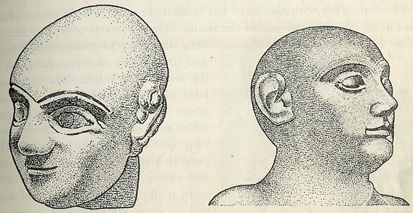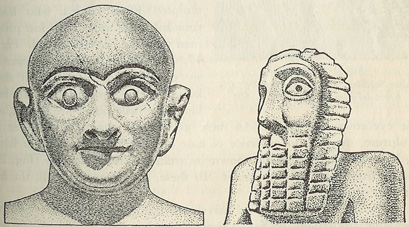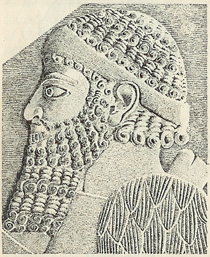|
(Chapter IV, section 3)
Iran and Iraq
Unfortunately for the compiler of a general book, both the archaeology and the somatology of the Iranian plateau and of Mesopotamia are in their respective infancies. City after city, and village after village, remain undug, while thousands of skulls, some excavated and discarded, and others still in the ground, remain unmeasured and unpublished. Despite the notable work done at al 'Ubaid, Kish, Ur, Warka, Susa, Persepolis, Rayy, and other sites, the archaeologists have not yet found the beginnings of Near Eastern civilization. Until recently, no single unquestionably Neolithic site had been discovered in the whole of Asia Minor, Mesopotamia, or the Iranian plateau over to India; at present several sites have been located in Anatolia and Armenia.4 In the Tigris-Euphrates Valley, the Neolithic material, if it exists, must be buried by many feet of alluvial soil. In the eastern highlands, if it exists, it should not be hard to find. The difficulty is that no one has seriously looked for it. The claim of this whole highland and riverine zone to priority in the development of the Neolithic economy cannot yet be confirmed or refuted. There is, however, another claimant equally lacking in credentials—the plain of west-central Asia, north of the plateau, and east of the Caspian. In the grasslands drained by the Oxus and Jaxartes the great nomadic cultures, associated with Indo-Aryan-speakers in the oldest traditional times, and later with the Turks, had their bed of germination. From this center, from time to time, invasions and migrations started in several directions. One was the movement of the Aryan ancestors into India, about 1400 B.C.; another the Iranian invasion of the plateau which bears the name and whose inhabitants speak the language of the invaders. A school, founded by the Indo-European philologists of the last century, and supported, although with different dramatis personae, by the modern Turks, would make of these vast plains the germinating-bed of Old World food production. Commencing with the Iranian plateau, we may consider skeletal material which antedates the arrival of the Iranian-speaking immigrants. Five crania from Luristan and the region directly to the north, in western Iran, represent the pre-Aryan period; three males and two females,5 dating from 2000—1100 B.C., are all variants of the general Mediterranean type in Cappadocian and Afghanian directions. An Early Copper Age type from southern Baluchistan, which may date from the third millennium B.C., is the same.6 We may surmise that the ancestors of the bulk of the present plateau population had arrived by the beginning of the third millennium In Mesopotamia, the earliest cultural remains have been found in Sumeria. Here there has been recognized a long predynastic period, subdivided into three phases—al 'Ubaid, Uruk, and Jemdet Nasr. These three probably occupied the fourth millennium B.C. The last two at least were Copper Age cultures, while the al 'Ubaid culture proper, as exemplified by the eighteenth to fourteenth levels at Warka, may possibly have its roots in a true Neolithic.7 One grave at Warka, in level 14, belongs to the latter part of the al 'Ubaid period, probably about 3700 B.C. The skull contained in it is said to be dolichocephalic. Two skeletons from perhaps equally early graves at al 'Ubaid itself powdered upon exposure, and could not be measured. Hence our knowledge of the people of the fourth millennium B.C. in Mesopotamia, based on indubitably contemporaneous remains, is practically zero. A series of seventeen crania from al 'Ubaid8 (see Appendix I, col. 4), which may be predynastic or early dynastic, belong without exception to a type which has been called Eurafrican, and which has been the most numerous and most characteristic element in the population of Mesopotamia from the time of the marsh dwellers at al 'Ubaid to the present day. These skulls are large, heavy, and purely dolichocephalic. They belong to the larger- and longer-headed Mediterranean division, nearest in vault size and form to the earlier Galley Hill and Combe Capelle. They differ in one important respect, however, from most European skulls of the same general type, in that their nasal bones are extremely prominent and highly placed. These early Sumerians, like the inhabitants of the Iranian plateau, had already acquired the projecting, aquiline noses so characteristic of the modern Near East. Like the plateau dwellers, these early Sumerians were Afghanian in race. Mesopotamia is not, like Egypt, an isolated valley, for it may be entered without great difficulty from the highlands to the east and north, while it forms a natural goal for the inhabitants of the Arabian uplands, made mobile by the fickle rainfall of the pastures. The history of Mesopotamia has consequently bcen a sequence of infiltrations and invasions from both the highland zone and the deserts, for the country feeds the city with men, and not the reverse. In studying the racial history of Mesopotamia from thc third millennium B.C. onward, we must remember this almost constant influx, and observe how it affected the Sumerians and the Semitic-speaking kingdoms. The series of skeletal remains at our disposal, other than the series from al 'Ubaid, include: (a) a series from Kish, from graves which may be dated at some time close to 2900 B.C.; (b) another from the same site, from fourth dynasty graves, prior to 2500 B.C.; (c) skulls of the third dynasty of Ur, dated about 2300 B.C. (d) Neo-Babylonian crania, from between 800 and 400 B.C. (e) Skulls from Kirkuk dated at the fifth century AD.9 In all, well over a hundred skeletons have been studied. Most of the skulls belong to the “Eurafrican” type already described, but two other types are represented in most of the series. One of these is an ordinary Mediterranean with a smaller skull and a higher cephalic index, which ranges between 70—80 and averages about 75. This Mediterranean type is more fragile, less rugged, shorter faced, and smaller in body size. This is apparently not an original Sumerian type, for it is completely absent in the earliest series from al 'Ubaid and Kish. It first appears well after 3000 and probably after 2700 B.C. in the fourth dynasty graves at Kish (see Appendix I, col. 5), and from then on seems to persist in all of the samples, except for the late Kirkuk series in the north. Like the larger “Eurafrican” this smaller Mediterranean type may still be distinguished in the living population of Iraq. The “Armenoid” racial type, which is the third one claimed in Mesopotamia, begins with the earliest Kish graves and continues through the Babylonian period. The identification of this type is not wholly certain, however, for very few actually brachycephalic skulls have been found, and, since facial portions of these are usually damaged, it is impossible to define the type clearly. Most of the so-called Armenoid skulls are mesocephalic or sub-brachycephalic, but, in a few instances, the cephalic index runs really high, in an extreme case, to 89. The occiputs of these skulls are said to be flat, the browridges heavy, and the capacities great. Although many of the skulls which have been called Armenoid may represent merely the rounder headed extreme of the total group, it is nevertheless probable that a planoccipital brachycephalic strain actually penetrated Mesopotamia during the third millennium B.C. Although it has since increased in numbers, it still forms but a minority. Except for these few brachycephals,
none of the invasions or cultural movements into Mesopotamia in historic
times has changed the population in any perceptible way. This would indicate
that the regions which FACIAL TYPES IN SUMERIAN ART
Although Mesopotamia was one of the great centers of Old World
civilization, and although its emissaries travelled hundreds of miles,
and its cultural influences were so far-reaching that we may feel them
even today, we must not attempt to link it directly with the Neolithic
invasions which entered Europe. The farmers who sought rich fields and
grassy meadows to the west of the Euxine and the Bosporus were not Sumerians
or Babylonians, but peoples who had started their wanderings before the
development of a metal age civilization, and who were affected only
indirectly by cultural emanations from its center. Nevertheless, this
somatological survey of early Iran and Iraq is of value in the larger
problem of the white race, for it enables us to define clearly the physical
characteristics of the Mediterranean types of man which were responsible for
what may have been the world’s earliest, civilization, and of the
surrounding regions from which it was fed, just as one could tell the
physical types of France from a study of Paris or of Europe from a study of
New York. 4 Pittard, E., ASAG, vol.
7, 1937, pp. 389—391.
|


